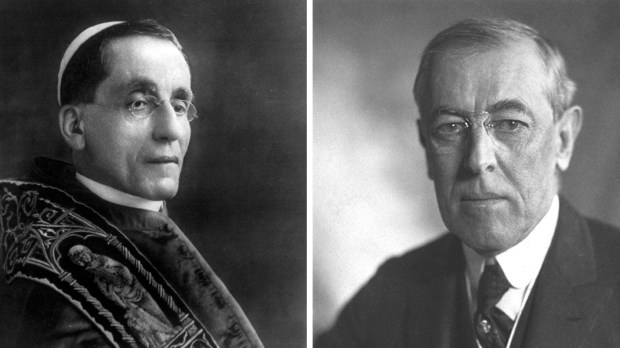It may be taken for granted today that the leader of the Catholic Church receives visiting heads of state at the Vatican, and that those leaders often reciprocate when the pope visits their country.
Recent U.S. presidents have welcomed traveling popes on their visits to America, and a good number of presidents have paid a call on the pope in Rome.
But who were the first pope and U.S. president to meet in person?
It was 100 years ago that that meeting took place—between Woodrow Wilson and Pope Benedict XV.
“On January 4, Mr. Wilson called upon his Holiness Pope Benedict XV,” according to a chronicle of recent events listed in the pages of America magazine at the time. Benedict, we are told, “welcomed him most cordially. They spent about a half hour together. It is not, of course, officially known what subjects they discussed.”
We can bet, however, that they talked about the latest developments in efforts to recover from what turned out to be a devastating war, the armistice of which had been called the previous November 11. And therein lies a tale, which is pieced together from other historical sources by America assistant editor Joseph McAuley, almost a century later:
Both [pope and president] were high-minded men who were statesmen in a world rent by war, disease and famine. Both saw the need for peace; but their approaches toward that goal were as different as their personalities: the pastoral pope sought to alleviate the suffering and hunger that resulted from the war while the wartime president sought to create a new world order on his terms, as he saw it. In those war years, various peace proposals were floated around, only to be shot down like the soldiers in the trenches. Pope Benedict was tireless in his efforts to prevent the war and then in his efforts to terminate it and afterwards, with his efforts to ensure a just peace. It consumed every minute of his pontificate from the moment he was elected to succeed the saintly Pius X on September 3, 1914.
Wilson was on a six-month, post-war tour of Europe (yes, while he was still a sitting president), and his time there included participation in the Paris Peace Talks that produced the Treaty of Versailles on June 28, 1919.
Both Wilson and Benedict had begun their respective tenures around the time war broke out in August 1914. “It fell to Benedict to find a way through what would become a disastrous four-year war,” McAuley writes. “It was the war that brought out the idealistic side of [Wilson,] the political science professor-president. He dreamed of a peaceful new world and he believed with everything that was in him that he was the divinely inspired instrument to bring about that peaceful world. Thus, both pope and president came up with their respective plans for peace.”
Pope Benedict’s plan for peace covered ten areas; the main theme of which was the resumption of peaceable relations between nations and the healing of a war-torn world through the assistance of those afflicted by homelessness, hunger and disease. All his pleas for peace were rebuffed; yet he kept trying. President Wilson, however, had other ideas. The American president—it was said—was jealous that the Roman pope had come out first with a prospective peace plan; Wilson felt that he could do better, hence his “Fourteen Points.” As the wags remarked at the time, Wilson had to come up four points better than the pope.
The public portion of the first meeting between the successor of St. Peter and successor of George Washington including the pope—formerly Giacomo della Chiesa—imparting his blessing upon the president and his retinue. Most of those present knelt for it, while Wilson, a Presbyterian, bowed his head. Benedict gave Wilson a gift, a mosaic of St. Peter. And that was that. Wilson went on to the Paris conference, while Benedict continued in his efforts to help the continent heal.
Interestingly, both men died at the same age—67—the pope in 1922 and the president two years after.
“Pope Benedict XV was honored at the time for his peacemaking efforts,” McAuley notes. “As for President Wilson, he would eventually be broken—politically as well as physically—by the strains of peace and he would die two years later, in 1924, … with his dreams of a League of Nations in tatters until two subsequent Democratic successors would revive it as the United Nations (FDR) and bring it to fruition (Harry S. Truman, upon FDR’s death in 1945).”

